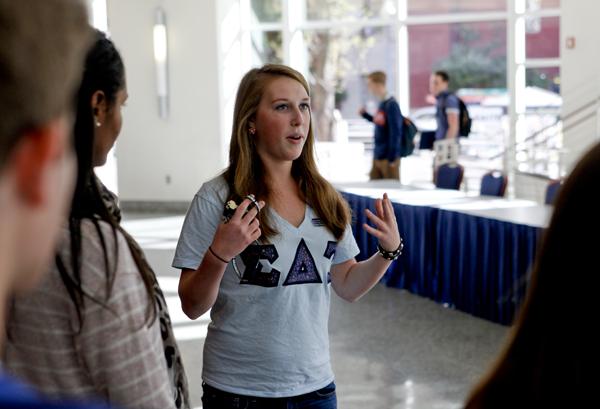National admissions experts will head to GW this fall to critically examine one of the key ways colleges influence prospective students – the campus tour.
GW hired a higher education consulting group called Render Experiences this summer to judge the effectiveness and appeal of the University’s tours, information sessions and the welcome center. The audit, which a previous client said costs about $1,500 plus travel expenses, will help GW lure more top students at a time when more prospective students are visiting campus.
More than 5,300 prospective students have visited GW this year since July, a 27 percent jump over the same period in the last two years. The firm will visit campus several times and present a report to admissions officials this spring.
The study will look at every part of a GW visit from the point of view of prospective students, starting with scrolling through the admissions website to sign up for a tour, then following the route to arrive at the welcome center and scrutinizing follow-up materials.
Karen Felton, GW’s director of undergraduate experiences, said she hopes the audit will help set GW apart from the competition.
“You go on a campus tour and at a lot of places, you hear the same things,” Felton said, pointing to safety features and the libraries. “When we have people here, I want them to understand why the experience they will have as a student at GW will be like none other that they would experience at another institution.”
She believes the audit will likely include recommendations to better direct prospective students around campus. Felton, who worked as a high school college counselor for four years, said she’s seen how a negative visit experience could impact a student’s decision to go to GW.
“I was always just blown away by the small and, dare I say, mundane things that my students would be affected by,” Felton said.
Jeff Kallay, the company’s founder and CEO, said schools are increasingly turning to firms like his to evaluate and revamp their visit experience.
“Each school has a culture and a DNA,” Kallay said. “We want to make sure that students for whom it’s a right fit, that school is authentically representing who they are and that they connect with students.”
Campus tours are second only to open houses as colleges’ most effective recruitment strategies, according to a survey this spring by the higher education firm Noel-Levitz.
Admissions officials also revamped campus tours a year ago: Tour guides now focus more on GW’s academic programs and play on the University’s rebranding efforts to tie classroom learning to the outside world.
Laurie Koehler, the University’s senior associate provost for enrollment management, said she hopes the audit will ensure prospective students “leave here and can’t stop talking about GW.”
Koehler worked with Kallay at her previous institutions, Bryn Mawr College and Miami University, and said it helped give an objective look at the college’s offerings.
At Miami University, Koehler said the firm helped tie in various aspects of the campus visit experience. During the audit there, dining services decided to offer samples of “toasted rolls,” a traditional campus snack during tours to appeal to visitors’ five senses.
“Lots of amazing ideas were generated by that energy,” she said.
The audit could also help GW’s student tour guides tell more powerful stories, which Kallay said was a key element to helping prospective students connect with a college.
After the Georgia Institute of Technology hired the firm two years ago, the admissions office simplified the tour routes and added more signs to help families navigate campus – leading to more positive reviews.
After the study, the office also asked Kallay to come back to help train hundreds of tour guides to improve their storytelling.
“I think before, that was something that we wanted them to do, but we weren’t stressing how important that piece was,” Meredith Ray, Georgia Tech’s senior assistant director of admissions, said.







